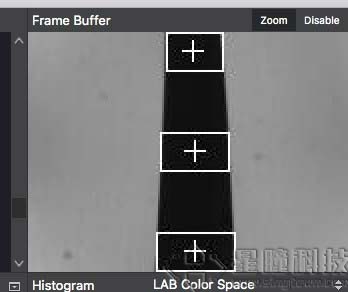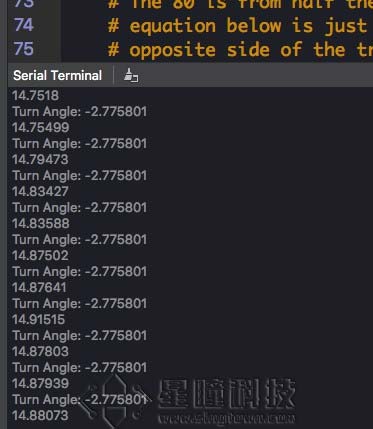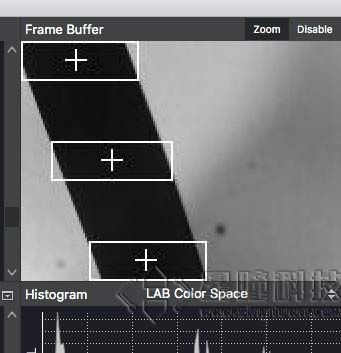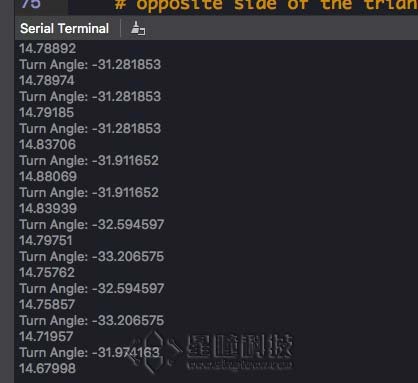例程讲解-10-line_flowing机器人巡线
视频教程20 - 巡线小车:https://singtown.com/learn/50037/
本例程为 10-Color_Ttracking-line_flowing
本例程的目的是利用机器视觉进行机器人巡线,程序输出机器人应该转弯的角度。
注意:需要保证只有一条线在视野内。
# Black Grayscale Line Following Example
#
# 跟随机器人做一条线需要很多努力。 本示例脚本显示了如何执行跟随机器人的
# 机器视觉部分。 您可以使用此脚本的输出来驱动差分驱动机器人遵循一条线。
# 这个脚本只是产生一个转动的值,告诉你的机器人向左或向右。
#
# 为了使这个脚本正常工作,你应该把摄像机指向45度左右的一条线。请确保只有线在相机的视野内。
import sensor, image, time, math
# Tracks a black line. Use [(128, 255)] for a tracking a white line.
GRAYSCALE_THRESHOLD = [(0, 64)]
#设置阈值,如果是黑线,GRAYSCALE_THRESHOLD = [(0, 64)];
#如果是白线,GRAYSCALE_THRESHOLD = [(128,255)]
# Each roi is (x, y, w, h). The line detection algorithm will try to find the
# centroid of the largest blob in each roi. The x position of the centroids
# will then be averaged with different weights where the most weight is assigned
# to the roi near the bottom of the image and less to the next roi and so on.
ROIS = [ # [ROI, weight]
(0, 100, 160, 20, 0.7), # You'll need to tweak the weights for you app
(0, 050, 160, 20, 0.3), # depending on how your robot is setup.
(0, 000, 160, 20, 0.1)
]
#roi代表三个取样区域,(x,y,w,h,weight),代表左上顶点(x,y)宽高分别为w和h的矩形,
#weight为当前矩形的权值。注意本例程采用的QQVGA图像大小为160x120,roi即把图像横分成三个矩形。
#三个矩形的阈值要根据实际情况进行调整,离机器人视野最近的矩形权值要最大,
#如上图的最下方的矩形,即(0, 100, 160, 20, 0.7)
# Compute the weight divisor (we're computing this so you don't have to make weights add to 1).
weight_sum = 0 #权值和初始化
for r in ROIS: weight_sum += r[4] # r[4] is the roi weight.
#计算权值和。遍历上面的三个矩形,r[4]即每个矩形的权值。
# Camera setup...
sensor.reset() # Initialize the camera sensor.
sensor.set_pixformat(sensor.GRAYSCALE) # use grayscale.
sensor.set_framesize(sensor.QQVGA) # use QQVGA for speed.
sensor.skip_frames(30) # Let new settings take affect.
sensor.set_auto_gain(False) # must be turned off for color tracking
sensor.set_auto_whitebal(False) # must be turned off for color tracking
#关闭白平衡
clock = time.clock() # Tracks FPS.
while(True):
clock.tick() # Track elapsed milliseconds between snapshots().
img = sensor.snapshot() # Take a picture and return the image.
centroid_sum = 0
#利用颜色识别分别寻找三个矩形区域内的线段
for r in ROIS:
blobs = img.find_blobs(GRAYSCALE_THRESHOLD, roi=r[0:4], merge=True)
# r[0:4] is roi tuple.
#找到视野中的线,merge=true,将找到的图像区域合并成一个
#目标区域找到直线
if blobs:
# Find the index of the blob with the most pixels.
most_pixels = 0
largest_blob = 0
for i in range(len(blobs)):
#目标区域找到的颜色块(线段块)可能不止一个,找到最大的一个,作为本区域内的目标直线
if blobs[i].pixels() > most_pixels:
most_pixels = blobs[i].pixels()
#merged_blobs[i][4]是这个颜色块的像素总数,如果此颜色块像素总数大于 #most_pixels,则把本区域作为像素总数最大的颜色块。更新most_pixels和largest_blob
largest_blob = i
# Draw a rect around the blob.
img.draw_rectangle(blobs[largest_blob].rect())
#将此区域的像素数最大的颜色块画矩形和十字形标记出来
img.draw_cross(blobs[largest_blob].cx(),
blobs[largest_blob].cy())
centroid_sum += blobs[largest_blob].cx() * r[4] # r[4] is the roi weight.
#计算centroid_sum,centroid_sum等于每个区域的最大颜色块的中心点的x坐标值乘本区域的权值
center_pos = (centroid_sum / weight_sum) # Determine center of line.
#中间公式
# Convert the center_pos to a deflection angle. We're using a non-linear
# operation so that the response gets stronger the farther off the line we
# are. Non-linear operations are good to use on the output of algorithms
# like this to cause a response "trigger".
deflection_angle = 0
#机器人应该转的角度
# The 80 is from half the X res, the 60 is from half the Y res. The
# equation below is just computing the angle of a triangle where the
# opposite side of the triangle is the deviation of the center position
# from the center and the adjacent side is half the Y res. This limits
# the angle output to around -45 to 45. (It's not quite -45 and 45).
deflection_angle = -math.atan((center_pos-80)/60)
#角度计算.80 60 分别为图像宽和高的一半,图像大小为QQVGA 160x120.
#注意计算得到的是弧度值
# Convert angle in radians to degrees.
deflection_angle = math.degrees(deflection_angle)
#将计算结果的弧度值转化为角度值
# Now you have an angle telling you how much to turn the robot by which
# incorporates the part of the line nearest to the robot and parts of
# the line farther away from the robot for a better prediction.
print("Turn Angle: %f" % deflection_angle)
#将结果打印在terminal中
print(clock.fps()) # Note: Your OpenMV Cam runs about half as fast while
# connected to your computer. The FPS should increase once disconnected.
运行结果:
直走:


左转:


右转:


